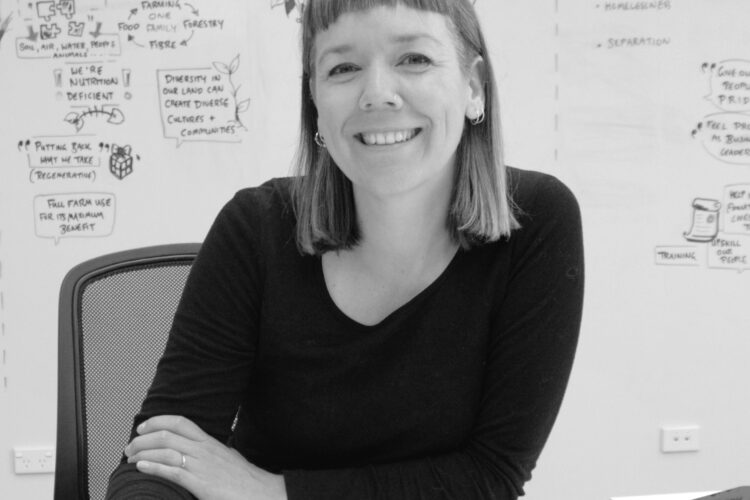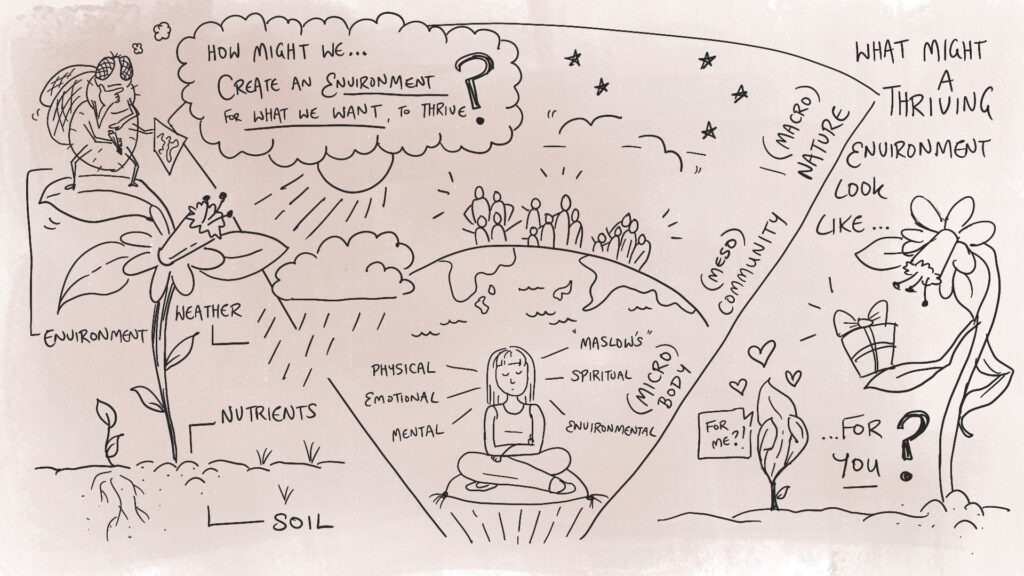
May 1st, 2022
Cultivating a Thriving Environment for All
Cultivating a Thriving Environment for All video
Reflecting on this past year working as a live illustrator, I realise I’m in this very privileged position where I get to be a ‘fly on the wall’ for many business workshops in New Zealand and around the world. I’ve listened to talks in the regenerative space, in diversity and inclusion, self-development, creativity and conscious leadership spaces. Sitting off to one side of the room, I quietly observe, synthesise and draw what I hear, reflecting back thoughts to expand on as the conversations unfold.
And I’ve noticed a common challenge that I want to share…
This challenge, written as a design thinking question, is this:
“How might we… create an environment for what we want to thrive?”
For me, the key words in this question are ‘environment’ and ‘what we want’. Let me explain what I mean, starting with the big picture and deducing it down

Take nature for example, a literal environment. What grows in your backyard depends on what growth the surrounding environment enables. And when I say ‘environment’, I don’t just mean weather. The environment is the full sphere of influence – It’s the soil quality, the food or nourishment, the plants around it, the type of seed, where you plant… etc. Another example is when a flower isn’t flowering, we change its location, it’s environment. We don’t immediately assume there’s something wrong with this flower, or that maybe this flower isn’t going to be a flower after all. The expectation is that flowers bloom, so what can we change to enable this flower to blossom? How can we create the environment for it to do its natural thing? We don’t need to control when or how the flower blooms or try and make it blossom. It’s just about enabling the conditions and then getting out of the way.
A more micro example closer to home is our body. Like nature, our body doesn’t work in silos either, it’s a product of its environment. The body is an ecosystem, designed to thrive. If we can provide the right environment, create the right conditions, things can tick away nicely. So, how can we enable the best environment, what’s our role in this? It might look like meeting our physical needs, our Maslow’s hierarchy of needs, meeting our emotional needs, spiritual needs. On the flip side, we can also be creating a thriving environment for things we don’t want, all through our thoughts, emotions, behaviours and actions. What does your body need to thrive the way you want it to? How can you create an environment for your body that is healing, nurturing, and balanced?
This environment concept also applies in our communities, our workplace cultures and society. How can we create an environment that enables our community to thrive? How might we work together to ensure the foundation around us – the ‘soil’ from our earlier example of nature – is rich in nutrients and able to nurture those around it? A foundation that creates a space which puts the stronger plants in a position to shelter those not yet strong enough to weather the storm. Or to put it in human terms, how might those most privileged help lift others? I find myself constantly looking to the natural environment and asking “What would nature do?”. For example; I love how trees share nutrients and information with each other via their root system underground, or how plants use what they need and when they have excess amounts of nutrients, instead of hoarding it or using it to compete against others, they share it with the plants around them.
Imagine if we have a society that did that, that truly mimicked nature?
What does a thriving environment look like for you?
Rhiannon James – Graphic Scribe Artist | Illustrator for Leadership Lab’s Te Kakau project

May 1st, 2022
Cultivating a Thriving Environment for All
Cultivating a Thriving Environment for All video
Reflecting on this past year working as a live illustrator, I realise I’m in this very privileged position where I get to be a ‘fly on the wall’ for many business workshops in New Zealand and around the world. I’ve listened to talks in the regenerative space, in diversity and inclusion, self-development, creativity and conscious leadership spaces. Sitting off to one side of the room, I quietly observe, synthesise and draw what I hear, reflecting back thoughts to expand on as the conversations unfold.
And I’ve noticed a common challenge that I want to share…
This challenge, written as a design thinking question, is this:
“How might we… create an environment for what we want to thrive?”
For me, the key words in this question are ‘environment’ and ‘what we want’. Let me explain what I mean, starting with the big picture and deducing it down

Take nature for example, a literal environment. What grows in your backyard depends on what growth the surrounding environment enables. And when I say ‘environment’, I don’t just mean weather. The environment is the full sphere of influence – It’s the soil quality, the food or nourishment, the plants around it, the type of seed, where you plant… etc. Another example is when a flower isn’t flowering, we change its location, it’s environment. We don’t immediately assume there’s something wrong with this flower, or that maybe this flower isn’t going to be a flower after all. The expectation is that flowers bloom, so what can we change to enable this flower to blossom? How can we create the environment for it to do its natural thing? We don’t need to control when or how the flower blooms or try and make it blossom. It’s just about enabling the conditions and then getting out of the way.
A more micro example closer to home is our body. Like nature, our body doesn’t work in silos either, it’s a product of its environment. The body is an ecosystem, designed to thrive. If we can provide the right environment, create the right conditions, things can tick away nicely. So, how can we enable the best environment, what’s our role in this? It might look like meeting our physical needs, our Maslow’s hierarchy of needs, meeting our emotional needs, spiritual needs. On the flip side, we can also be creating a thriving environment for things we don’t want, all through our thoughts, emotions, behaviours and actions. What does your body need to thrive the way you want it to? How can you create an environment for your body that is healing, nurturing, and balanced?
This environment concept also applies in our communities, our workplace cultures and society. How can we create an environment that enables our community to thrive? How might we work together to ensure the foundation around us – the ‘soil’ from our earlier example of nature – is rich in nutrients and able to nurture those around it? A foundation that creates a space which puts the stronger plants in a position to shelter those not yet strong enough to weather the storm. Or to put it in human terms, how might those most privileged help lift others? I find myself constantly looking to the natural environment and asking “What would nature do?”. For example; I love how trees share nutrients and information with each other via their root system underground, or how plants use what they need and when they have excess amounts of nutrients, instead of hoarding it or using it to compete against others, they share it with the plants around them.
Imagine if we have a society that did that, that truly mimicked nature?
What does a thriving environment look like for you?
Rhiannon James – Graphic Scribe Artist | Illustrator for Leadership Lab’s Te Kakau project

